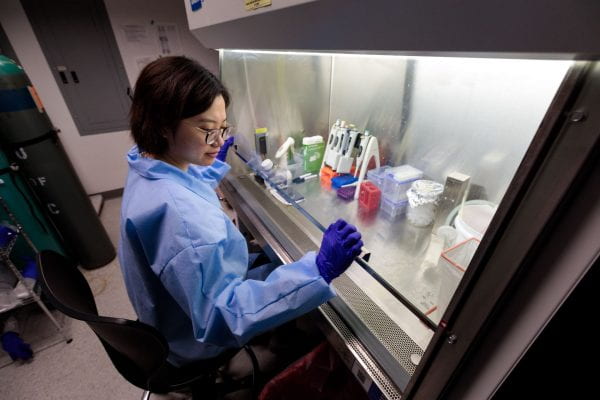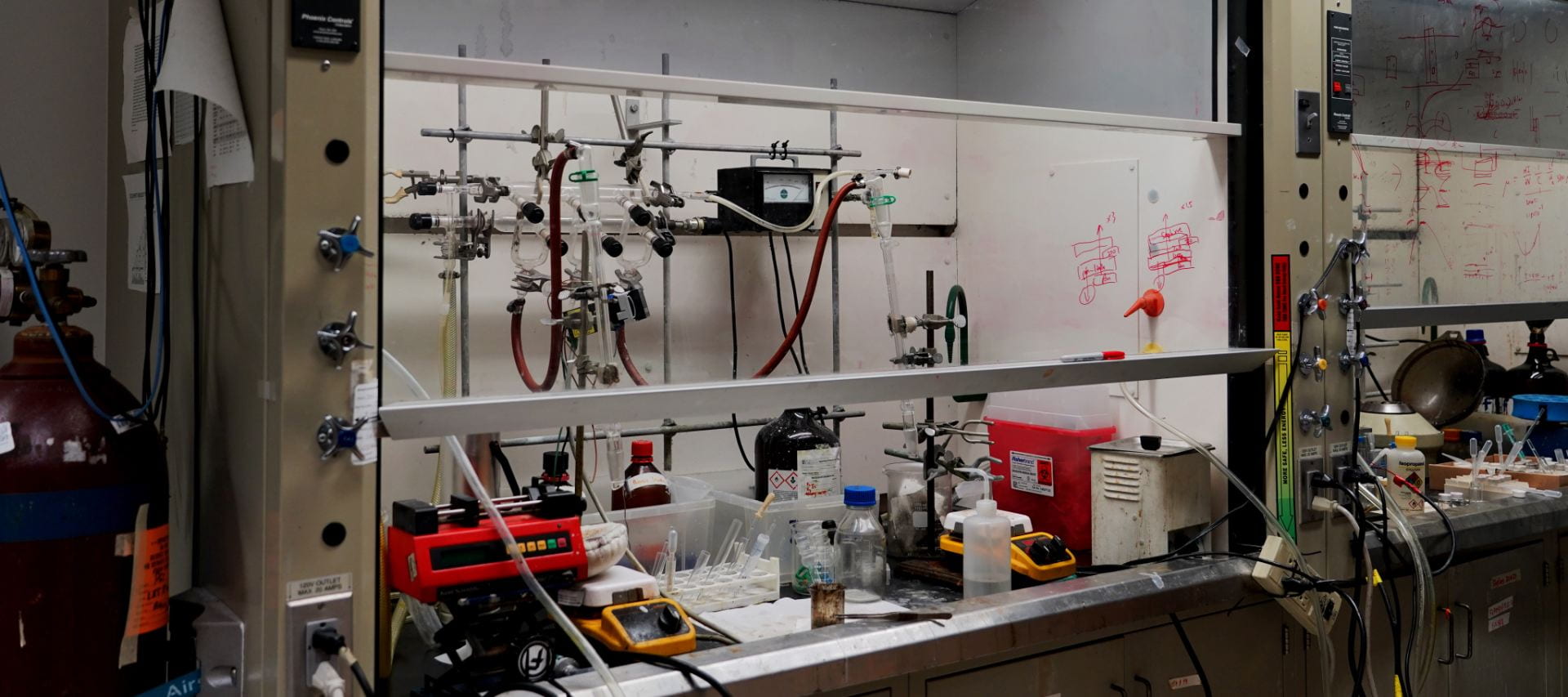Shut the Sash

An Energy Conservation Behavioral Campaign
Laboratories are the most energy-intensive buildings at UChicago and fume hoods are one of the primary drivers of that energy use.
When open, a single fume hood can consume as much energy as 3.5 homes in 24 hours.
To save energy and stay safe, fume hood sashes should only be opened to set up or modify an experiment. The UChicago “Shut the Sash” campaign aims to motivate sash closure when fume hoods are not in use to save the energy within labs. The campaign began in Searle Chemistry Laboratory in 2017 and has yielded significant positive impacts. UChicago Facilities Services, in partnership with the Physical Sciences Division and Environmental Frontiers, is expanding the Shut the Sash program throughout the rest of campus. The competition component is currently running in Gordon Center for Integrative Sciences, Searle Chemistry Laboratory, and the William Eckhardt Research Center.
How it works
Using the building automation systems, the real-time fume hood sash position is recorded every 15 minutes. The data is then aggregated for each fume hood on a monthly basis. Rankings for the best performing laboratories, energy savings, overall progress of the Shut the Sash initiative, and any notable updates coming from the data are distributed to department heads and newsletter subscribers on a regular basis.
All fume hoods under each PI are considered as a group. Twice a year, the lab groups that perform the best in the following categories will win certificates and recognition events, like donut and pizza parties.
- Lowest average sash position
- Greatest percent reduction from their baseline data (baseline data is the average of data collected from the previous six months)
What you can do
- Shut the sash on your fume hood whenever you walk away from it and remind fellow lab users to do the same.
- Only use the button labeled “Ventilation Start” in an emergency. It increases air exchange to maximum capacity and is extremely energy intensive. Pull the button out to deactivate.
- Always turn off occupancy switch after completion (if one is present).
- If the hood does not have an occupancy sensor, reduce the exhaust on weeknights and weekends (or at times when the laboratory is not in use).
- Never store chemicals in the fume hood.
- Lock / decommission fume hoods not in use for extended periods of time.
Spring 2025 Winners
GCIS
- Arac-Ozkan’s Lab — Best Overall Performance
- Engel’s Lab — Best Overall Performance
- Nagel’s Lab — Best Overall Performance
- Anderson’s Lab — Greatest Improvement
- Hopkin’s Lab — Greatest Improvement
- Perozo’s Lab — Greatest Improvement
ERC
- Tirrell’s Lab — Best Overall Performance
- de Pablo’s Lab — Best Overall Performance
- Meyer and Vieregg’s Lab — Best Overall Performance
- Swartz and Hubbell Lab — Greatest Improvement
- Tirrell’s Lab — Greatest Improvement
- Rowan’s Lab — Greatest Improvement
Searle
- Dickinson’s Lab — Best Overall Performance
- Snyder’s Lab — Best Overall Performance
- Dong’s Lab — Best Overall Performance
- Rawal’s Lab — Greatest Improvement
- Levin’s Lab — Greatest Improvement
- Snyder’s Lab — Greatest Improvement
Winter 2025 Winners
GCIS
- Lee’s Lab — Best Overall Performance
- Nagel’s Lab — Best Overall Performance
- Engel’s Lab — Best Overall Performance
- Hopkin’s Lab — Greatest Improvement
- Yu’s Lab — Greatest Improvement
- Irvine’s Lab — Greatest Improvement
ERC
- Tirrell’s Lab — Best Overall Performance
- Carlstrom’s Lab — Best Overall Performance
- de Pablo’s Lab — Best Overall Performance
- Meyer and Vieregg’s Lab — Greatest Improvement
- Swartz and Hubbell’s Lab — Greatest Improvement
- Privatera and Wakely’s Lab — Greatest Improvement
Searle
- Dickinson’s Lab — Best Overall Performance
- Snyder’s Lab — Best Overall Performance
- Dong’s Lab — Best Overall Performance
- Dong’s Lab — Greatest Improvement
- Dickinson’s Lab — Greatest Improvement
- Levin’s Lab — Greatest Improvement
Spring 2024 Winners
GCIS
- Kuehn’s Lab — Best Overall Performance
- Lin’s Lab — Best Overall Performance
- Adams’ Lab — Greatest Improvement
- Lee’s Lab — Greatest Improvement
- Jureller’s Lab — Greatest Improvement
- Tian’s Lab — Greatest Improvement
ERC
- Huang’s Lab — Best Overall Performance
- Hubbell’s Lab — Best Overall Performance
- Swartz’s Lab — Best Overall Performance
- de Pablo’s Lab — Greatest Improvement
- Tirrell’s Lab — Greatest Improvement
- Meyer’s Lab — Greatest Improvement
- Vieregg’s Lab — Greatest Improvement
Winter 2023 Winners
Searle
- Snyder’s Lab — Consistent Performance
- Dong’s Lab — Best Overall Performance
- Patel’s Lab — Greatest Improvement
GCIS
- Engel’s Lab — Consistent Performance
- Scherer’s Lab — Best Overall Performance
- Moellering’s Lab — Greatest Improvement
ERC
- Tirrell’s Lab — Consistent Performance
- Rowan’s Lab — Best Overall Performance
- Hubbell’s Lab — Greatest Improvement
Fall 2022 Winners
Searle
- Rawal’s Lab — Consistent Performance
- Dickinson’s Lab — Best Overall Performance
- Dong’s Lab — Greatest Improvement
GCIS
- Jureller’s Lab — Consistent Performance
- Krishnan’s Lab — Best Overall Performance
- Irvine’s Lab — Greatest Improvement
ERC
- Swartz and Hubbell’s Lab — Consistent Performance
- Tirrell’s Lab — Best Overall Performance
- Rowan’s Lab — Greatest Improvement

Sustainable Lab Resources
This calculator from the Lawrence Berkeley National Laboratory takes inputs such as electricity costs, fume hood width and height, operating hours, and face velocity to calculate outputs including annual electricity totals, annual cost, and CFM with a variety of visualizations.
Labconscious is an open resource for the life science community to reduce laboratory waste, use green chemistry, conserve water, and save energy.
The EPA Sustainable Facilities Tool for Laboratories
This interactive tool allows users to compare sustainable strategies and materials for a variety of lab systems and spaces.
Reduce Laboratory Energy Use: U.S. Department of Energy Better Buildings Toolkit
This toolkit provides guidance and strategies for reducing energy consumption in laboratories.
My Green LabⓇ is an organization with a mission to build a culture of sustainability through science by uniting scientists, vendors, designers, energy providers, and other stakeholders. Their programs help scientists to reduce the environmental impact of their work and gather data on sustainable best practices to provide the scientific basis for greening the culture of science labs.
ACT: The Environmental Impact Factor Label
The ACT label serves as an eco-nutrition indicator for laboratory products, furnishing details regarding the environmental consequences of production, utilization, and disposal of the product and its packaging.
Center for Energy Efficient Laboratories (CEEL)
CEEL collaborates with scientists, manufacturers of laboratory equipment, facility managers, and utility companies to pinpoint potential avenues for enhancing energy efficiency within laboratories.

Frequently Asked Questions
What is a fume hood?
A fume hood is a piece of equipment enclosing a work space in a laboratory. It is usually a four to eight-foot metal encasement with a shatterproof glass partition, or sash, that slides down to just above the hands that are doing a chemical experiment. Powerful blowers in the hood provide ventilation that limits exposure to hazardous fumes released during experimental procedures by pulling air away from the researcher’s face to outside into the air. It protects the researcher and the rest of the lab.
Why do fume hoods use so much energy?
Labs require more air exchanges than other spaces on campus. The heating, cooling, and ventilation required to keep labs at optimal temperatures use a significant amount of energy. A lab’s treated air is exhausted straight to the outdoors through the fume hood and cannot be recirculated.
How does shutting the sash save energy?
Many fume hoods at UChicago are variable air volume (VAV), meaning that a motor varies the air flow depending on the sash height. The motor and fans work harder when the sash is wide open and HVAC systems also have to work harder to condition the air. The fan speed and volume of air being moved decreases when the sash is lowered, all of which results in significant energy savings.
Is it safe to shut the sash?
The sash is an important safety barrier between the fume hood interior and the laboratory. The fume hood sash should only be open when setting up an experiment or when directly manipulating substances within the hood, and then open only to the lowest level necessary to perform the experiment. Always close it fully when not in use. Even when shut, there is still some air flow through the hood to remove any fumes.
Email the Office of Sustainability at officeofsustainability@uchicago.edu with any questions.
